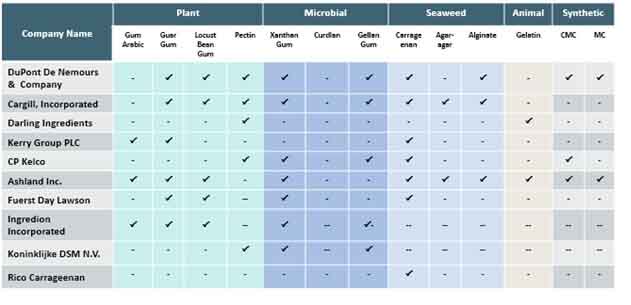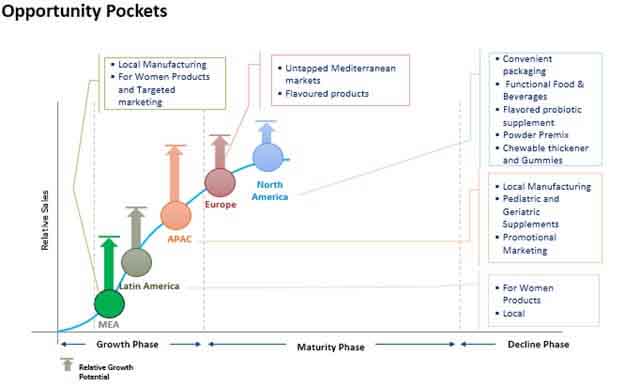Reports
Reports
The globalization has led to health awareness among individuals, which, in turn, has resulted into a demand for the better quality and textured food. The increasing awareness about the availability of better ingredients in the market is driving the food texturant market growth.
Texturants, a class of specialty ingredients, are used to control and customize the mouthfeel, taste, and texture (physical properties) of food and beverages. The desired textured food always attracts customers’ interest and this factor is enhancing food texturant market. These texturants are not only made up of synthetic chemicals but also are extracted from natural substance. The appearance is crucial to food industry. Even the food tastes better but does not have compelling texture, one can hardly buy that dish again. So, these texturants are directly added to the food products to get the desired physical appearance.
The change in food habits, changing lifestyle, awareness toward availability of better ingredients to improve quality and stability of eatables, and increasing inclination for processed food are key features to drive market growth. The increased number of working population is extending the demand for the processed food that finally results in the growth in food texturant market. But the uncontrollable use of food texturants can increase its use as a food addictive. This can put adverse impact on human health. But a genuine application of texturants in bakery and confectionery, oils and fats, dairy and frozen desserts, sweet and savory snacks, beverages, and meat products, can boost the market growth.
Food Texturant Market Outlook
The global food texturant market has witnessed a rise in demand from all major food processing regions. The introduction of a food texturant(s) in processed food helps reduce fats and sugar content significantly. Also, shelve stable dynamics of food texturants help manufacturers design more efficient processed foods in terms of stability and profitability. The food texturant market is expected to be driven by the growing functional foods and beverages industry in developed as well as developing regions. The food texturant market is expected to witness a significant transition of offerings by key players from traditional food texturants to clean label offerings as the former types tend to offer limited health benefits. This transition is expected to incorporate naturally-sourced food texturants, such as agar, carrageenan and other microbial hydrocolloids, and further boost the demand for food texturants as they are comparatively cheaper and easily available. Bakery products, confectioneries, snacks, beverages, and sauces are considered to be major end-users for the food texturant market and since these industries are witnessing steady growth, the food texturant market is also expected to have a positive outlook over the forecast period. North America is expected to dominate the global food texturant market over the forecast period, owing to the region’s vast food processing industry.
Food Texturant Market: Reasons for Covering This Title
Growing consciousness regarding healthy food has compelled key manufacturers to exclude specific ingredients or considerably reduce their content with the introduction of replacers, of which food texturants are a major part. Technological changes and newer and natural food texturants have significantly helped the food processing market overcome the general notion of the unhealthiness of food texturants. This change in dynamics and incorporation of newer and healthier products make the food texturant a lucrative market to participate in for ingredient manufacturers.
Global Food Texturant Market: Segmentation
On the basis of nature, the global food texturant market can be segmented as:
On the basis of type, the global food texturant market can be segmented as:
On the basis of application, the global food texturant market can be segmented as:
On the basis of form, the global food texturant market can be segmented as:
Global Food Texturant Market: Key Players
Some of the key players operating in the global food texturant market are, Tate & Lyle Plc., Koninklijke DSM N.V., E. I. du Pont de Nemours and Company, BASF SE, Cargill, Incorporated, Darling Ingredients Inc., Kerry Group PLC, CP Kelco, Ashland Inc., Fuerst Day Lawson, Ingredion Incorporated, Rico Carrageenan (W Hydrocolloids, Inc.), BENEO GmbH, ABF Ingredients Group, and Ewald-Gelatine GmbH.
Hydrocolloid Offering by Key Manufacturers:

Source: In-house Analysis, 2018
Key Product Launches in Food Texturant Market
Key product launches in the food texturant market over the recent years are observed to be targeting ethical buyers and vegan populations.
Opportunities for Market Participants in Food Texturant Market
Developing regions, such as Asia Pacific and Latin America, are pegged to be major growth regions in terms of value and volume in the overall food texturant market. The developed regions of North America and Europe are estimated to experience steady demand in the conventional segment and exponential growth in the clean label segment, which can be attributed to the clean label food trends prevalent in the region. The beverage segment is expected to be a substantial revenue generating segment, owing to the expanding on-the-go food and beverage sector with consumer inclination towards taste and texture. Over the forecast period, the clean label food texturant segment is expected to register a high growth rate and subsequently, contribute to the significant growth of the food texturant market.

Source: In-house Analysis, 2018
N/A